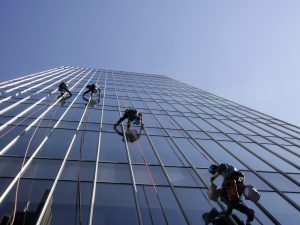The U.S. Occupational Safety and Health Administration, OSHA, included an interesting section in the scaffold standards when they were issued in 1996. It is the section called “Use.” Since it is included in the scaffold standards, I think we can obviously assume it to be the use of scaffolds. Do you know what’s in it? Do you know to whom this section applies? Is it the scaffold “user” or is it perhaps the erector? Well, the snappy answer is: the user. But that doesn’t mean the erector should ignore it. After all, the erector has to make sure the scaffold is constructed correctly so the user can safely use it. So let’s take a fresh look at the section’s content and see how it applies to users of scaffolds.
- Don’t overload the scaffold; Now there is a really good idea!
- Don’t use lean-to or shore scaffolds; Good idea too, especially if you know what a lean-to or shore scaffold is. If you don’t know what it is, then how will you comply with the standards? (Picture a saw horse cut in half, with each half several feet apart leaning against the wall. Now throw a couple of plank across them and stand on the resulting platform. You are relying on friction to keep you in the air—that’s why they’re illegal.)
- All scaffolds shall be inspected by a competent person before each work shift and after any occurrence that messes up the scaffold; Great idea. Remember, the competent person is one who can recognize the hazards and has the authority to do something about it. The competent person must also be familiar with the OSHA scaffold standards.
- If you break the scaffold, brace it up until you can replace the broken part; This standard allows the use of components that get damaged while in use (as opposed to using damage parts when you build the scaffold). You do have to install a temporary fix so the structural integrity of the scaffold is not compromised.
- Don’t move a scaffold horizontally with workers on it; If you want to do that, make sure that it is designed for that purpose by a Registered Professional Engineer. This does not apply to rolling towers/mobile scaffolds.
- Don’t zap yourself; Erectors should know this too because this standard addresses electrocution or the avoidance thereof. There are two charts, one for insulated lines and one for uninsulated lines. If the line has 50,000 volts, you are required to stay 10 feet away. At 52,000 volts, you need to stay 10 feet, 0.8 inches away. I wonder how you would measure that. Perhaps using your metal tape measure? Maybe not.
- Don’t mess with the scaffold; This standard and #3 above are the most important standards in this section. It requires that all scaffolds be erected, moved, dismantled, or altered only under the supervision of a competent person, qualified in scaffold erection, using trained and experienced workers. In other words, users keep your hands off the scaffold.
- Don’t use a scaffold that has ice, snow, greasy stuff or slime on it; Of course, you can get on it if you’re the one stuck with cleaning it off.
- Don’t let swinging loads hit the scaffold; Use a tag line. We actually have to have a standard to warn users of this—amazing!
- If you are hanging by a rope, that is a suspended scaffold, make sure the rope diameter is compatible with the brake and hoist; We don’t want you sliding down the rope.
- 11. If you are still hanging by a rope, make sure that you don’t burn the rope or let acid or other nasty corrosive materials eat away at it; Good idea.
- Don’t work on scaffolds in high wind; The natural question is: What is a high wind? We let the competent person (See #3) determine that. If you choose to work on a scaffold in a high wind you must wear, and utilize, personal fall protection equipment or erect wind screens. Of course, if you install wind screens, you must have the scaffold designed for the extra force from the wind. On the other hand, if you have to use personal fall protection to stay on the scaffold, you really should think about giving it up for the day.
- Don’t let excess stuff, that is debris, to pile up on the platform; And don’t throw it over the side either.
- The ubiquitous 5 gallon buckets, along with other makeshift devices cannot be used to make the scaffold higher; Let’s get real—why wasn’t the scaffold built higher in the first place?
- This standard addresses the use of ladders on scaffold platforms; We don’t want your ladder sliding off the platform or exerting a sideways force that will make the platform slide off the scaffold structure. We also do not want the ladder to knock the scaffold over and we don’t want the ladder be unstable due to the legs bearing on two separate planks. Finally, secure the bottom of the ladder. Of course, if possible, just build the scaffold higher (see #14).
- Make sure you planks don’t sag, that is deflect too much; How much is too much? Well, for 10 feet the max you are allowed is 2 inches while for 7 feet it’s 1-25/64 inches and for 5 feet it’s 1 inch.
- Welding and suspended scaffolds can be a tough combination; This standard addresses the associated hazards. If you are a welder and you don’t know what to do to protect yourself, stay off the scaffold until you find out. You should see lots of insulation on the suspension ropes and covers over the motors in addition to proper protective rigging and grounding. Don’t even think about taking chances with this one.
Well, there you have it: A review of the “Use of Scaffolds.” And you thought it was going to be complicated. Remember, inspect your scaffold before each work shift and don’t mess with the scaffold if you are the user. If you need something modified, ask the competent person, qualified in scaffold erection, and his/her trained and experienced crew to do the modifications.












